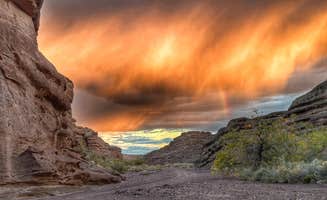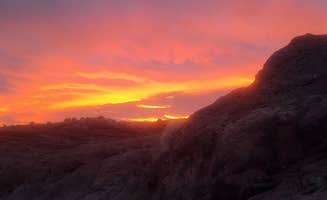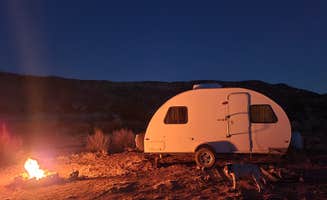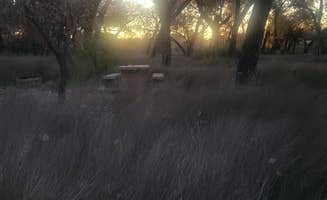The landscape around La Joya sits at approximately 4,800 feet elevation, with juniper-dotted hills transitioning to desert scrubland. This region of central New Mexico experiences dramatic temperature fluctuations between day and night, particularly in spring and fall. Most free camping near La Joya requires high-clearance vehicles due to unpaved access roads that can deteriorate after rainfall.
What to do
Rock climbing opportunities: The Box Recreation Area offers numerous climbing routes on limestone cliffs. The area attracts climbers of various skill levels. As one visitor noted, "Rough Tent Camping...Great Rock Climbing. Drove down the night before in order to go climbing the next day. Found a decent spot in a dry wash to put up the tent for the night. It worked and allowed quick access to the crag in the morning."
Hiking through canyons: San Lorenzo Canyon Dispersed features multiple slot canyons and interesting rock formations accessible by short hikes. According to a camper, "Not easy to find but gorgeous spot to hike many canyon trails. Zero cell service. Don't follow goggle to find."
Bird watching: Winter visitors should prioritize camping near Bosque del Apache Wildlife Refuge between November and February. The refuge hosts thousands of sandhill cranes and snow geese. One camper at San Antonio Bosque Park shared, "We just arrived at this free campground. Concrete picnic tables and fire rings provided. We are surrounded by what looks to me like oak trees, but I have yet to confirm that. We are near the Rio Grande Bosque, and are looking forward to our ventures observing the migratory birds of the area."
What campers like
Stargazing conditions: The minimal light pollution throughout the region creates exceptional night sky viewing. A visitor to The Box Recreation Area remarked, "One of my favorite places I've stayed. Will definitely come back! Several hiking trails with beautiful views! A lot of great climbing also! Spectacular views and lots of wild life! A great place to star gaze!"
Solitude and remoteness: Manzano Mountains Camp offers peaceful camping among ponderosa pines. A camper noted, "Took awhile to get here, well off the beaten path. Ponderosa Pines, oak and juniper scrub. Ample supply of downed trees to use as firewood. Gets muddy if it rains."
Convenience to Interstate 25: Several dispersed camping areas provide quick access from major highways. At The Box Recreation Area, one visitor commented, "This was a lovely spot to overnight just about 20 minutes off I-25 near Socorro NM. Great views and incredible star gazing. This is an important rock climbing destination and there are several hiking trails if have more time than we did."
What you should know
Fire restrictions: Check current regulations before planning to have a campfire. Many areas implement seasonal restrictions during dry periods. At San Antonio Bosque Park, a reviewer noted, "There are 5 larger spots with picnic tables and fire pits. While here, several long travel trailers parked in the first 2 spots. Then there are several other spots down the dirt road suitable for vans or small campers."
Cell service variability: Coverage strength depends on specific location and carrier. At San Lorenzo Canyon Basecamp, one camper shared, "Went in about 2 miles. Passed a few sites but cell signal got weak to non existent the further I got in. I have Verizon. Anyhow turned around and took the first site going in. 4 bars with Verizon."
Wildlife encounters: Bear activity has been reported in some camping areas. A visitor to San Antonio Bosque Park warned, "What has not yet been noted is that there is a lot of fresh black bear scat throughout the campsite with higher concentrations the further you go back, past the five spots with fire rings. No sightings and a problem free night but do take into consideration."
Tips for camping with families
Choose established sites: Areas with defined camping spots offer easier access and setup. San Antonio Bosque Park provides concrete picnic tables and established sites. A camper observed, "Nice spot in the cottonwoods room for about 10 with good space in between. Concrete tables with fire pits although there's restrictions right now. It is right off the road and a little steep to get into."
Pack all supplies: No services or amenities exist at most dispersed sites. One visitor to The Box Recreation Area advised, "10-15 down 60 west of Socorro you'll find 'the box' climbing area. This is on BLM land, and there is no trash pick-up or other managed facilities here, so camping is at your own discretion and you MUST leave the area as you found it (or better)."
Consider seasonal timing: Spring and fall offer more moderate temperatures than summer. Winter nights drop below freezing regularly. A camper at San Antonio Bosque Park shared, "I decided to stay here last minute and arrived after dark on Jan. 21st. It was easy to find- look for the drive just to the side of the canal. There are 2 dirt roads - take the upper one to the right, and within a few hundred feet there is a steepish driveway to the right down to under the trees."
Tips from RVers
Look for flat pull-offs: Some areas offer limited space for larger vehicles. At Bianca Ranch Road - BLM dispersed, a reviewer cautioned, "Only did about 10 minutes of driving around. Several small spots a couple feet off the main road. Nothing that would support 30'+ trailers. It's open desert with low shrub."
Scout ahead when possible: Many access roads deteriorate significantly after wet weather. At Manzano Mountains Camp, a camper noted, "This area is very wooded. Could get muddy when it rains. Lots of sites. Big rig friendly."
Consider proximity to amenities: No hookups exist at dispersed sites, so plan accordingly for water and waste disposal. A visitor to The Box Recreation Area shared, "Stopped at the first parking area and it was flat, empty and quiet. We didn't travel up the road to the spot the other reviewers stayed but we enjoyed the easy drive in."





